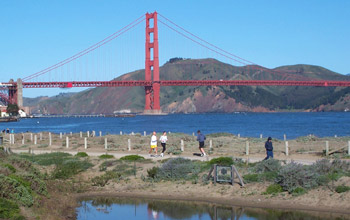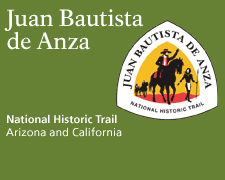 |
 |
Welcome to the Juan Bautista de Anza National Historic Trail - 1210
miles of deserts, rivers, oak woodlands, shorelines, grasslands,
and chaparral. It's as urban as Tucson, Los Angeles, and San Francisco,
and as rural and wild as Anza-Borrego Desert State Park. Entwined
in a city or isolated from civilization, this trail offers adventure,
excitement, and an opportunity to experience history in the places
where it occurred.
 |
 |
 |
The end of the Anza trail |
Photo: NPS |
 |
The trail commemorates, protects, marks, and interprets the route
traveled by Anza during the years 1774 - 1776. Starting in Sinaloa
and Sonora, New Spain (which is now in Mexico), he brought
over 200 settlers to San Francisco to establish a mission and presidio
there. This feat is made more remarkable when you realize that the
west was still a vast wilderness, and cities such as San Francisco,
Los Angeles and Santa Barbara did not yet exist. The Anza Trail
is therefore unique in its location and historical context. It connects
Mexico to San Francisco, and the 18th century to the 21st. It invites
travelers to experience the interweaving of the three elements of
the Spanish plan for the colonization of its northern frontier:
presidios (military forts), missions (religious centers),
and pueblos (civilian towns). By following the trail, it
becomes easier to grasp the links between the presidios of Tubac,
Santa Barbara, and San Francisco, and to see patterns in the location,
construction and use of Spanish Missions. By visiting sites marking
the humble beginnings of the cities of San Josť (founded in 1777)
and Los Angeles (founded in 1781), their modern development becomes
even more marvelous.
Anza encountered many American Indians along his travels,
and many were instrumental in the success of his expeditions. The
richness and variety of American Indian cultures is therefore also
displayed along the trail. For example, visitors can learn about
the materials and techniques of Rumsen basket weaving along
the marked trail on Fort Ord Public Lands in Monterey. You can visit
the O'odham plaza at Mission San Xavier del Bac, picnic at
the Tongva portion of Smith Park near Mission San Gabriel,
or explore the vitality of the Chumash culture at several
sites.
The National Park Service promotes the preservation of public access
to areas related to the Anza expedition so that they can be enjoyed
and appreciated. The purpose of the Anza Trail is thus to preserve
a significant part of the history of the southwest and to provide
the means for a diverse group of Americans to make connections to
the story of the Anza expeditions and the people affected by them.
You can have a firsthand appreciation of many of the experiences
of expedition members. You can drive the Anza Trail from Nogales,
Arizona, to San Francisco, California, or simply visit places in
between to experience the trail and its stories at your own speed.
You can walk, hike, or ride along the recreational trail, or visit
nearly a hundred historical sites.
Details about individual counties along the trail can be reached
through the County Selection List above.
Driving directions, hiking and biking ideas, sites of interest and
links to additional resources on the Web are all included on these
pages.
In the words of Captain Juan Bautista de Anza, "¡Vayan
subiendo!" (Let's go everybody!).

|
 |
 |



